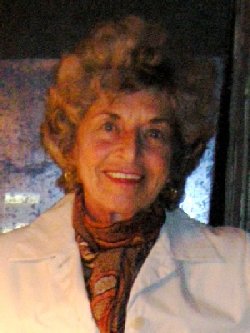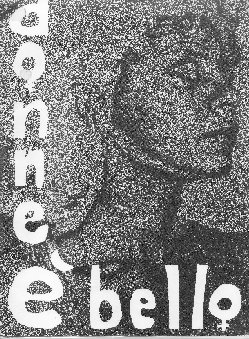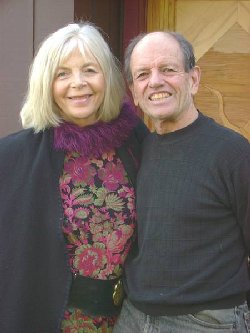|
NOTE: Languages such as Italian use certain gender-specific words, but English doesn't, and bilingual people may occasionally run into translation roadblocks (i.e."al femminile"). Serena's created her own way of expressing her thoughts, sometimes taking liberties with grammar (i.e. "Women is beautiful"). She likes the original way she uses words, some of which have even drifted into the general parlance. SERENA LUCE CASTALDI - A FOUNDER OF THE FEMINIST MOVEMENT IN ITALY
I remember my family as quite unhappy--people who didn't get along were stuck together, and strife and resentments ran deep. Everybody tried to escape, and my mother found a more rewarding work environment teaching French in middle school. When I was about 10 my parents separated; my father and two brothers moved out and I remained with my mother and sister. While more peaceful, our family life was not my idea of fun, and I spent as much time as possible outside of it, with friends and schoolmates. The school discipline of sitting still for hours did not suit my vivacious nature, and besides the social aspect of it, in class I was mostly bored. Yet I still had to follow my father's decision that humanistic education was best, and attended a classical high school steeped in Latin and ancient Greek. From childhood through high school my best friends were twins, Giovanna and Giulietta. Our trio coalition provided my growing years with female solidarity and unwavering support, emotional intimacy, fun, strength and a good deal of freedom of movement. Together we discussed our family lives, relations, how being female proved to be a social disadvantage, how to best protect ourselves from unwanted attention and be able to take part in the many stimulating things city life had to offer: movies, concerts, debates, museum visits. Very early I became aware of the disrespect that often followed the start of sexual contact with boys. Also I did not like being a sexual prey, exposed to inappropriate touching on the bus, men exposing themselves in the streets, or following me with lurid comments when I walked. Reflecting on all this, I concluded that I could be considered either a female or a person. I chose to be a person, rejected most sexual advances, and cultivated friendships with both boys and girls. Around 1964, following my family's intellectual tradition, I enrolled in the State University of Milan, where I eventually graduated with a degree in philosophy. Around that time my father, the authority that had determined much of what I was allowed to do, died, leaving me an economic independence that gave me a new freedom of choice. I quickly put it to use to start fulfilling my desire to travel, a part of my life that is still important to me. While on vacation in France I met Agathe, who invited me to visit her in Paris, where she lived with her sister. We developed a close friendship; each winter I visited her and in the summer she joined me at my family apartment in the Italian Riviera. We became fluent in each other's language, and by mixing the two created our own secret dialect. Living with her in the Quartier Latin, I had a chance to experience a lifestyle quite different from the more conservative Milano. After Paris, the swinging London of the Mary Quant era offered me another opportunity to plunge into another culture, with unconventional and colorful images of femininity. In 1967 the student movement came to my university. For the first time I got involved in politics, participated in meetings and occupation of the university, and by 1968 I was fully engaged in a Marxist-Leninist branch of the student movement. Another central woman in my life was Anna, my beloved sister-in-law and best friend until her death in 1977. It was with her that I went to New York in 1970, where I was introduced to the women's movement. While living there I met Anselma Dell'Olio and Diana Alstad and had the opportunity to speak with them in Italian about the developing women's movement. This allowed us a much more fluid and deep communication and the connection with Diana proved very significant, as it inspired me to look more closely into the Movement's philosophy and goals. As I considered writing my doctoral thesis on this subject, I visited groups and collected documents that I brought back to Milan.
To keep spreading the Liberation vision, I translated many of the documents I had collected and in 1972 L'Anabasi published them independently under the title "Donne e' Bello," which translates as "Women is Beautiful." The grammar is not correct, but sometimes when I write I stretch the language to precisely express the meaning I want to convey, and in the process create new expressions. That same year L' Anabasi published a small collection of our own material: "Al Femminile," Femminile (feminine) is a word to indicated gender; here this gender connotation is used to indicate that one's perspective is marked by gender. This idea was so successfully communicated that the expression al femminile was promptly adopted by the media, has since been used in all cultural fields, and has became part of common language. L'Anabasi lasted five years during which--besides regular consciousness raising meetings--it instituted Soccorso Femminista to listen to and counsel women in distress; organized feminist vacations; out-of-town gatherings with women from all over the country; and contributed to shaping the collective debate in the growing Italian Women's Movement. In 1974 a publisher invited me to write a book on Women's History in Modern Times, to introduce this new topic in high schools. I accepted and with a woman in my group, Liliana Caruso, wrote "L'altra Faccia della Storia, Quella Femminile" ("The Other Side of History, Herstory;" 1975). This book was also a "first" and inspired further historical research on women. It was fascinating to reflect on how to define women's history and what to include in its account. The idea of looking at "the other side of history" has caught on and the expression has been adopted by many others to present their particular point of view on certain events. I made my most theoretical contribution in the thesis I wrote for my philosophy doctorate, which was published in 1978 as "Femminile Pateriale" (Paterial Femininity). Pateriale means generated by the father (pater), like materiale (material) is related to the root word mother (mater). In this philosophical and anthropological essay, among other things I discuss the fallacy of the idea of the existence of a matriarchal stage in the evolution of society, and the origin of the values associated with femininity, which, I assert, have been generated by a male culture that has attributed to itself the exclusive power to define reality. I then affirm the necessity of moving to a "different mode of history." In it, the universality of the male culture is abandoned, replaced by the recognition that males and females both have essential roles and experiences providing them with different points of view needed and valuable, and females are encouraged to discover, embrace and shape their own identity. It seems to me that the value of the fundamental role of women in reproducing and maintaining the species (a prerequisite to the existence of any culture and society) is still largely relegated to the society's unconscious, invisible and taken for granted, as the Earth itself has mostly been. In 1975 I retired from L'Anabasi, and to find new tools for deepening the exploration of who we women are, I hosted two new small groups. In Gruppo del Carattere we used various structures to broaden our perception of who we are and shake our self-images. For example, in turns one of us was silent, while the others would talk about her as if she weren't there, letting her hear what was previously unspoken. The other group was dedicated to Danze Interiori (Interior Dances), and was conducted in collaboration with another feminist, artist Nilde Carabba. Here the center of attention moved to the body and its expression through spontaneous movements that let the unconscious emerge. One or at times two women lay down in the center with eyes closed; then from a place of deep relaxation she let the movements spontaneously come, while the group was witnessing and making sure she remained safe. This was followed by a time for comments and a potluck.
In 1976 I accepted the invitation of Diana Alstad and her partner Joel Kramer to visit them in Bolinas, the village where they live on the California coast, and in 1979 I ended up moving here. As leaving Italy meant I largely lost the possibility to communicate in my native language, in Bolinas my focus shifted toward the exploration of the mind-body relations, yoga, the healing arts, creativity through dance and the performing arts. Eventually more confident in my English, I returned to writing, contributing articles to the local papers and also experimenting with performance--poetry, theatre and more personal texts, a choice of which I collected in a sort of autobiographical testimony to my first 50 years: "Seeds of Wholeness" 1995), which I self-published. TO REACH SERENA: serena@serluce.com
|


